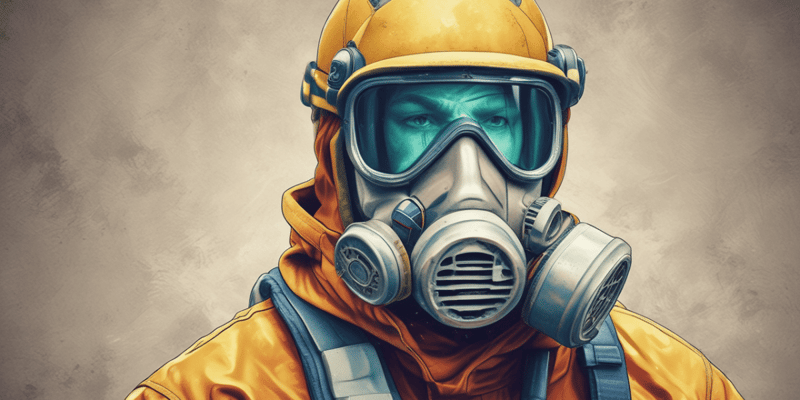Podcast
Questions and Answers
Study Notes
Equipos de Protección Respiratoria (EPR)
- UNE-EN 132: Defines terms and pictograms for respiratory protection equipment.
- UNE-EN 134: Provides nomenclature for the components of respiratory protection equipment.
- UNE-EN 133: Classifies respiratory protection equipment.
- UNE-EN 135: Lists equivalent terms for respiratory protection equipment.
- Methods of Testing: Numerous parts (1-8) for testing different aspects of respiratory protection equipment, like leakage, resistance to breathing, practical behavior testing, flame resistance, flammability, climatic conditions, carbon dioxide content, particle filter penetration, and dolomite dust obstruction. UNE standards associated with each part are listed.
Classification of Respiratory Protection Equipment (133)
-
Dependent on Ambient Air:
-
Demand Valves:
- Airflow controlled by breathing
- Filter types for particles (physical)
- Filter types for gases/vapors (chemical)
- Combined gas and particle filters available
- Semi-autonomous: Air supply from a source;
-
Demand Valves:
-
Independent of Ambient Air:
- Positive Pressure:
- Air Supply System
- Self-contained
- Closed circuit
- Auto-generators
- Regenerators
UNE-EN 149: Respirator Masks
- Material: Cellulose, covering nose, mouth and chin
- Protection: Against non-toxic particles (white color code)
- FFP1: Recommended for concentrations up to 4xTLV
- FFP2: Recommended up to 12xTLV
- FFP3: Recommended up to 50xTLV
UNE-EN 143: Filters against Particles
- Color Band: White
- Testing: With ClNa and paraffin mist
- P1: Low efficiency (80% retention for solid particles)
- P2: Medium efficiency (94% retention for solid and liquid aerosols)
- P3: High efficiency (99.5% retention for solid and liquid aerosols)
UNE-EN 141: Gas and Vapor Filters and Combined Filters
- Types and Classes: Listed by type and use, e.g., gases with boiling point above 65°C, below 65°C, inorganic gases, sulfur dioxide, ammonia, specific substances, mercury vapors, nitrogen oxides.
- Class 1-3: Different capacity levels for usage.
- Airflow Pattern: Filters are often used in series – particulates first, then gases.
Equipment Independent of the Ambient Air
- Semi-Autonomous: Equipment includes face masks, air regulators, support belts, user's own bottle (2 or 3 liters), quick-release valve, hose reel, air bottles (200-300 atm) or portable compressor.
- Autonomous (Closed Circuit): Provides protection similar to open-circuit but air is heated during extended use. Two main types- chemical regeneration (potassium peroxide) or oxygen addition (soda lime).
- Regulation: Equipment must comply with pressure equipment regulations (e.g., Real Decree 2060/2008).
Additional Information
- Maintenance: Frequent maintenance and replacement of parts (filters, membranes, valves) are crucial.
- Pressure Testing: Periodic pressure tests are mandatory to ensure equipment reliability.
Pressure Equipment & Testing
- Regulations: Real Decree 2060/2008
- Norms: UNE-EN standards on respirators (e.g., 12021, 14594, 14387)
- Maintenance: Regular maintenance, inspections, and replacements are necessary
- Testing: Includes visual inspections, and hydraulic tests.
- Bottles: Composite fibre carbon, 6.8 liters, 300 bar service pressure, 450-bar test pressure, and 2,040 L air reserve capacity
Studying That Suits You
Use AI to generate personalized quizzes and flashcards to suit your learning preferences.
Related Documents
Description
Este cuestionario explora los estándares y clasificaciones de los equipos de protección respiratoria. Se abordan normas UNE relacionadas y los métodos de prueba para garantizar la efectividad de estos equipos. ¡Pone a prueba tu conocimiento sobre la seguridad respiratoria!



